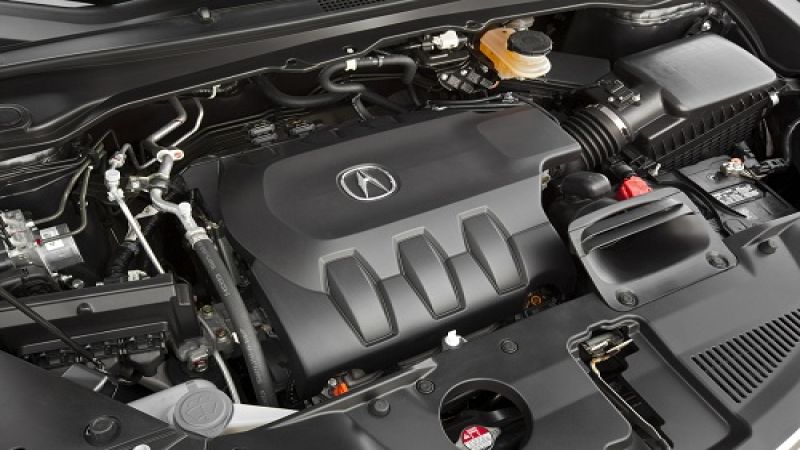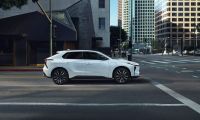The 2013 Acura RDX has proven to be an excellent test case to prove or disprove manufacturers’ claims that small turbocharged engines deliver the same power and better fuel economy. Many manufactures even go further saying that the turbocharged small engine delivers a better driving experience than the larger, normal aspirated engines from the same line of cars. It is easy to assume this is all true, but is it? Let’s take a look at this model closely and pick one other for comparison to see if the turbo engine is really more efficient and if customers prefer its driving dynamics.
A few years back when Acura introduced the RDX it highlighted two main things; the Super Handling All Wheel Drive system and the new turbo 4-cylinder engine. This was a new path for Honda/Acura, who had always been a normally aspirated engine company in the US until this point in time. This was about the same time that Acura had just about completed killing off its best-selling car model the Integra, which was later rebadged and restyled. Acura chose to abandon this premium pocket rocked market to pursue clients that had a little more education, years lived, and better zip codes on their addresses. Acura thought that the new engine might be well received by its upscale targeted cliental. When the vehicle was driven by customers and the motor press the overall impression was positive. Sales were never tremendous, but it was not a flop. Now Acura has introduced almost exactly the same body style, but with a totally different personality.
Let’s look at the Spec. sheet of the 2013 Acura RDX and the prior model. The old turbo engine (which was supposed to be state of the art just a few years earlier) had 240 HP and the 2WD version had EPA rated fuel economy of 19 city/ 24 highway. The new 6-cylinder engine, which is basically the same engine Acura has been using in other Honda and Acura models all along, now has an EPA rating in the same car of 20 City / 28 highway. So in other words the new engine has dramatically better fuel economy and it is a 6 cylinder non-turbo. Oh, and it has 273 HP, about 14% more power and 15% better highway mileage. Other things changed on the Acura including the transmission, so the comparison only goes so far. However, the transmission is not revolutionary and could have been used all along.
With regard to driving dynamics, let’s let the customers speak. Even though Acura dropped the high-tech all-wheel drive system and kept the body almost identical, the new RDX has jumped up in sales 142% according to an Acura press release this week. Perhaps the turbo lag was an issue? Perhaps customers prefer smoother V6 engines with more power and better fuel economy?
In order to give this story some balance let’s take a second example, the Toyota Rav-4, which is a similar vehicle to the RDX in terms of size and shape. Toyota has long offered the vehicle in both V6 and 4-cylinder (non-turbo versions). Mid-cycle, Toyota implanted its newest 4 cylinder engine that has its latest fuel savings technology. The V6 is basically unchanged. In that vehicle the standard 4-cylinder has mileage ratings of 22/28 mpg. The V6 has ratings of 19/27 mpg. However, although the 4-cylinder is slightly better in terms of fuel use the driving experience is dramatically different. The V6 RAV-4 has long been one of Toyota’s fastest vehicles. The 4 cylinder is not considered quick by any means.
Looking closely at the turbo vs. normally aspirated engine debate yields some surprising facts. The 2013 Acura RDX provides an excellent comparison of which drivers choose given the option.












Comments
I vote: dislike; what a tool!
Permalink
I vote: dislike; what a tool! I guess one exception (and only because it was an old engine not really designed for fuel economy) makes it a myth (what about the Ford Escape 2013 and all the other turbo charged engines that are now far more fuel economical).
They really should start with dislike buttons!
The Escape is a great vehicle
Permalink
In reply to I vote: dislike; what a tool! by Anonymous (not verified)
The Escape is a great vehicle despite its many serious recalls. I've tested it twice and the 1.6 turbo is a good, tiny, engine. It gets 30 highway and it is a slow vehicle (9 seconds 0-60). Not a great example because nobody is pretending this small engine is a replacement at the same mileage as a powerful V6. However, I will try to explain the point. The Ford Mustang with a 3.7 liter V6 (305 hp) gets 31 mpg highway (bigger engine, normally aspirated, more mpg than the small turbo engine in the Escape, similar weight vehicles). I maintain that if Ford put their Mustang's V6 in the Escape it would have had the same fuel economy or better than the weak 1.6 turbo. And it would not be slow. 30 mpg is nothing to brag about and the Escape is sloooow. The RDX is Faaast, and nearly as fuel efficient. And by the way Honda specifically developed the 2.3 turbo (acccording to their own press releases to save fuel. The real reason was to save money.
http://www.fueleconomy.gov/feg/PowerSearch.do?action=noform&path=7&year=2013&make=Ford&model=Escape%20AWD&srchtyp=ymm
I would suspect these sales
Permalink
I would suspect these sales figures have more to do with the prevailing mythology in our culture that bigger numbers are better. If given a choice between a 4-cylinder and a V6, most will automatically choose the V6 and not look at any other information.
In upscale markets, people expect larger engines in a larger car. It's just how it is. Technically, there are V4s capable of propelling a full-sized sedan just fine, but nobody would buy one simply because they'll see a big car with a tiny engine and scoff.
I mostly concur with the two
Permalink
I mostly concur with the two examples given. However, turbocharger technology continues to advance, and there may be genuine fuel efficiency gains coming. The challenge for engine designers is to combine small engine size, turbocharging, and fuel economy while maintaining the refinement of larger naturally aspirated engines which have more cylinders. So far, none have achieved all of these goals. An example is the new highly turbocharged BMW four cylinder engines with direct fuel injection. They are notably less refined to operated than BMW's six cylinder engines, most of which are also turbocharged. The culprit appears to be the smaller quantity of cylinders which creates fewer firing impulses per revolution and offers poorer inherent engine balance.
hi tom i have miata 1992 and
Permalink
hi tom i have miata 1992 and i custom made a turbo kit ..all ready inlalsted so i wanna do the 1.8 diff conversion so i wondering if you can tell me where i can get one of these complete rear end .and what is the price ..thanks and regards .
Interesting read. I propose
Permalink
Interesting read. I propose the problem is manufacturers are trying to make four cylinder turbo equivalent to a v6. This is not the path to fuel economy. The nx200t makes 230ish torque from 1650 rpm up. This is a very boosted engine. All the time. I really think we should embrace turbo lag for what it is. We got a tiny four cyl down the highway and a little kick when needed. There are many mistakes going on. Why not have a variable turbo boost setting for the driver. Just like a radio knob. Then my highway cruise is aS I expect it. Backed down and set for fuel. But if I'm feeling aggressive in heavy traffic I can turn it up and knowingly suffer the fuel consequences. The sti does some of this now.
Now if I were to design a cvt it would have two knobs one for boost to a constant rpm engine tuned for efficiency at that specific rpm. and another to my foot tuned to adjust gear ratio controlled vehicle speed and not power. I've driven the new crv and it's the biggest dog in the world off the line. My grandma hits the throttle harder off the line on an icy road. Sure don't want to be sitting in a left hand turn lane in that car. scary! Perfect example of not what to do. Sorry honda but we have two of them so my comment qualifies.